5 Ways For Better Plants!
Do you like live plants but want better results? World of Water shows you five easy steps for better plant growth.

1. Lighting
Light is a fundamental requirement for all plants. Light must be provided in the correct wavelength and colour temperature for plants to photosynthesize, and on for the right duration throughout the day.
Most of our plants come from the brightly lit areas of the tropics, and we need to replicate that in our aquariums if they are to thrive.
Add reflectors to standard T8 tubes or use high-powered T5 tubes to provide sufficient light, and that usually means two or more light tubes per tank.
As a rough guide, best plant growth will be provided by 0.5 watts of light energy per litre, or 50 watts of lighting per 100 litres of water.
The colour temperature of artificial lighting is important for plants, so check the colour temperature (measured in Kelvin or “K”) when you buy your next light tubes.
Plants grow best in colour temperatures of between 2000 and 10,000K. This can be catered for by Hagen SunGlo, Life Glo, or Flora Glo. Plug lighting into a timer and set it to come on for 10-12 hours per day.
2. Substate
Proper substrate choice can mean the difference between success and failure with plants. Plants need substrate to anchor and to take up nutrients, and the substrate needs to be of the right grade and depth to be able to do just that.
Fine substrates of between one and five millimetre diameter are best, with three millimetre being a good average size. The particle size of substrates is important because too coarse, and nutrients are washed away, and if it’s too fine, the gravel can become anaerobic and the roots will rot. Always make sure that the gravel is pH neutral, or inert, as most plants do not do well in very hard, alkaline water. Layer gravel to a depth of between 5 and 10 cm to enable the plants to send down roots. This deeper-than-average substrate depth should not be vacuumed too heavily as any fertilisers will be removed. Use a combination of algae-eating and substrate-feeding catfish to keep your gravel clean.
3. Substrate Fertiliser
Once gravel has been chosen, a fertiliser must be added to provide the plants with their food. As good as any sand, gravel or grit is, they are mostly sterile so they need a substrate fertiliser in order to allow the plants to take up nutrients.
Some very hardy plants like Egeria take nutrients from the water and will survive in sterile substrates, but most aquatic plants like Vallisneria, Amazon Sword plants and Cryptocoryne need food. Compare your substrate and plants to those in your garden. Few, if any, will survive in a pot of gravel, and instead need soil.
Special aquatic soils, eg Tetra Complete Substrate, are available from World of Water along with fertiliser tablets and powders to make sure you achieve good results. Tetra Complete Substrate is an excellent substrate fertiliser and will help you on your way to successful plant growth.
There is another element that aids growth of aquatic plants.
A heating cable is a low-wattage cable that is placed under the gravel, amongst the fertiliser or soil. It doesn’t need to be controlled by a thermostat and is not warm enough to heat the tank by itself.
Instead, heating cables provide gentle convection currents in the substrate and turn your gravel into a slow propagator, gently warming the roots and easing the movement of nutrients.
Heating cables are not essential, but they have been the key to success in many Dutch-style planted aquariums for the past few decades.
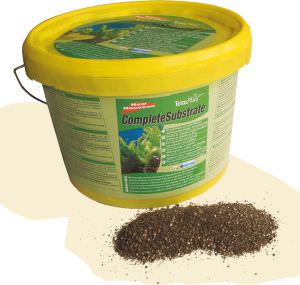
4. Liquid Fertilisers
Liquid fertilisers are meant to top up any deficiencies that may occur in the water. As plants grow, various essential elements may be used up like iron, and the regular addition of a liquid fertiliser can help make up any deficiencies.
Add liquid fertilisers on either a weekly or daily basis, and their ease of use and proven results often mean that they are the first tool used to aid better plant growth in any freshwater aquarium.
Use as directed as overdosing may cause algae. Liquid fertilisers are good for when your plant leaves look a little yellow. Use as part of a complete fertilization and lighting package for best results.
5. Carbon Dioxide
This is without doubt the biggest breakthrough in plant aquaculture over the past few years. Carbon is one of the basic building blocks for all life, and when presented to plants in a way they can use, the results can be spectacular.
To understand the benefits of carbon dioxide we must first look at photosynthesis. In the daytime, plants absorb carbon dioxide (CO2) and produce oxygen. They use the carbon that they have absorbed to build their structures and to grow.
In the aquarium, CO2 can be deficient in the day time as filtration and aeration drive off CO2 – good for fish but not so good for plants. By adding CO2 through a diffuser, more CO2 is available in the water for plants and they will not only survive, but thrive.
CO2 can be added to the aquarium safely by use of a fermentation kit (like the Nutrafin system) or from a pressurised system (like the Hydor kits). Individual CO2 bubbles are added to the water in a way that is safe for the fish, and the plants repay us by producing extra oxygen for the fish, fighting algae and soaking up nitrate and phosphate.
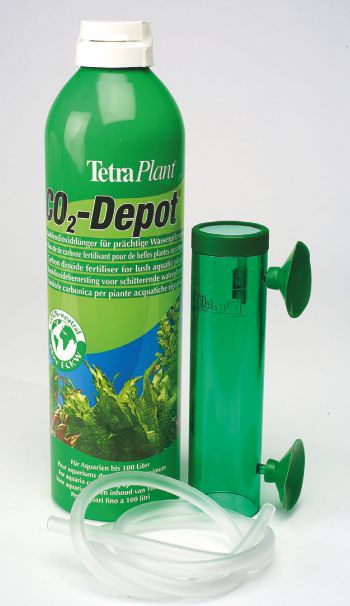
Tip: All the best planted aquariums in the world use a combination of the right substrate, Fertilisers, lighting and co2. Give it a try, you won’t be disappointed!
Five Great Aquarium Plants
1. Name: Amazon sword, Echinodorus bleheri
Origin: South America
Size: 45cm/18”
Water parameters: pH 6-8, temp 20-30°C
Lighting: One or more tubes
Notes: Amazon swords are large plants for the midground and come in a variety of sizes and colours. They send out long roots and need to be planted in a nutritious substrate. Combine with algae-eating fish to keep the large leaves free of algae.
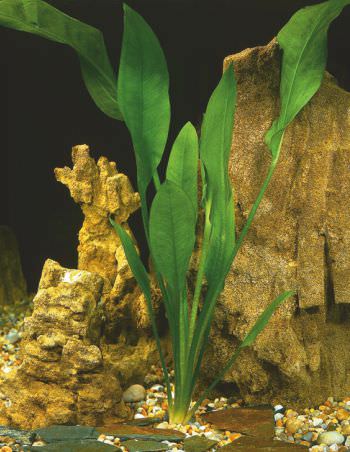
2. Name: Vallis, Vallisneria spp.
Origin: Widespread throughout the world
Size: Up to 180cm long depending on species, but usually shorter.
Water parameters: pH 6-8.5, temp 15-30°C
Lighting: One or more tubes
Notes: Vallis looks like long grass and it is usually planted at the back of the aquarium, where the long leaves flow in moving water. It can get long and spread by runner, but the additional shade provided by the surface leaves may help to suppress algae underneath. Hardy and undemanding.
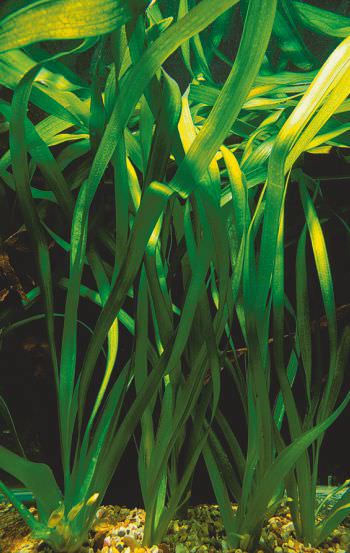
3.Name: Java fern
Origin: South-east Asia
Size: 30cm /12”
Water parameters: pH 6-8, temp 20-30°C
Lighting: Suitable for low lighting conditions
Notes: Java fern has a very natural look and can be tied to wood or rocks for good effect. Its tough leaves withstand even plant-eating fish in some cases, and it grows happily in conditions that are unsuitable for most other plants.
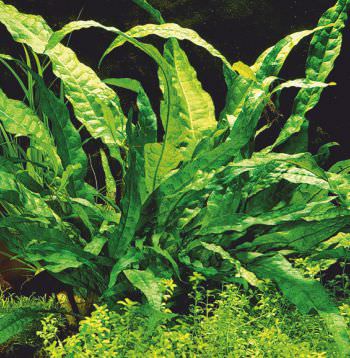
4.Name: Crypts, Cryptocoryne spp.
Origin: South-east Asia
Size: 10-20cm/4-8”
Water parameters: pH 6-8, temp 20-30°C
Lighting: One or more tubes
Notes: Crypts are commonly used to plant the foreground and their compact, rosette shape and ease of growing has made them popular. They are slow growing and appreciate substrate fertilisers.
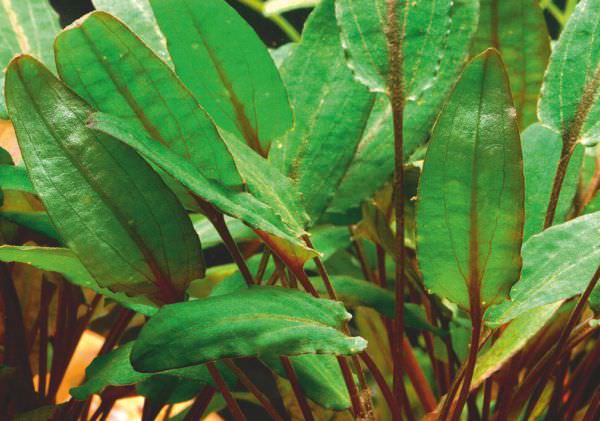
5.Name: Green cabomba, Cabomba caroliniana
Origin: America
Size: Up to 90cm
Water parameters: pH 6-8, temp 15-30°C
Lighting: Two or more fluorescent tubes
Notes: Cabomba is a good space filler, and it’s good at hiding equipment like heaters and filters too. It’s a fast grower in bright light and only needs a liquid food added to the water. Egg scattering fish may use it for cover and for scattering their eggs over, but don’t combine it with large, destructive fish.
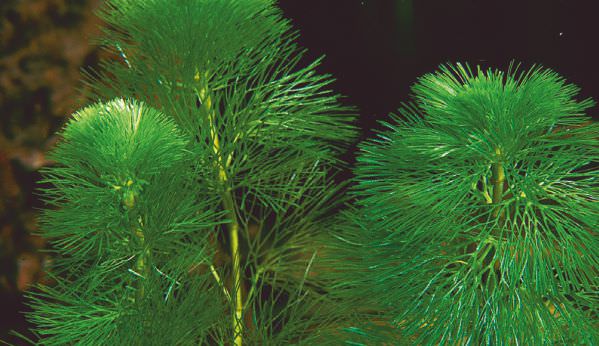
 British Pounds
British Pounds
